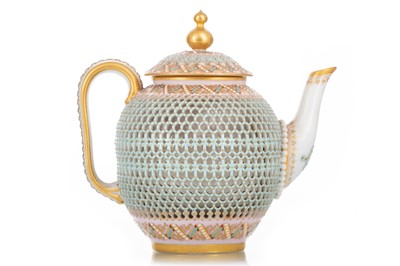12th Oct, 2023 14:00
The Traditional Interior | Fine Furniture & Works of Art
GEORGE OWEN FOR ROYAL WORCESTER
A FINE RETICULATED TEAPOT WITH COVER
of double walled globular form, the outer wall pierced with wide bands of honeycomb, the spout with pierced lozenge shaped panel, the lid with reticulation and double knop spear finial, the piercing coloured in light blue with gold dots, the pink borders with zigzag designs of white and turquoise jewels, the handle with a band of larger turquoise jewels, applied mark in relief and printed mark in puce, date letter for 1878
12.5cm high
In 1859 English potter George Owen (1845-1912), at only age 13, started work with Royal Worcester, where he was employed as a china presser in the ornamental department. He was responsible for cutting holes in porcelain using a moulded outline to imitate Sevres and Chinese examples.
The ambidextrous George Owen set about perfecting the technique so that the finished product was made up of much smaller piercings, finer than those found in either the Chinese or Sevres creations. Always experimenting, Owen’s technique and his multiple kiln visits risked months of work with the ever-present possibility of having to start over a constant shadow.
The 1896 edition of the Pottery Gazette best summed up the process when it reported “the artist (Owen) tooled every one of these miniature apertures without having any tracery, or any other assistance whatever to guide him to regularity, except his eye and hand… if on the last day of his work his knife had slipped, and so made two ‘holes’ into one, the whole piece would have been ruined”.
So secretive was Owen about his technique, he worked behind closed doors and hid his tools if anyone entered his workspace. Even his own son, who provided thin-walled vessels for Owen to perforate, was never allowed to watch. Before he started work, he would use a pair of compasses and callipers to carefully measure the distance around a vessel, marking where each incision should be made – and then create the hexagonal holes with a sharp, oiled knife, deftly swapping from hand to hand as he worked his way around the piece.
To date, no one has managed to replicate the finesse of Owen’s work.
A condition report is offered as an indication of any issues visible to the naked eye. As none of our staff is a professional conservator or restorer, buyers must satisfy themselves in respect of condition. The condition report does not form part of any contract between McTear's and the buyer, and all lots are offered "as is" in accordance with our Terms of Business available on our website.
Sold for £2,600
Estimated at £4,000 - £6,000
Condition Report
Condition generally good. Very light age related wear including gilt rub. Two surface hairlines (approx. 3cm) to the base of the teapot, though these are just to the surface and do not appear within. Manufacture seam to the spout. Multiple additional images now available
Request a free auction estimate
Complete the form below and one of our specialists will get back to you.



















